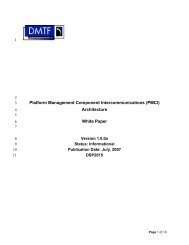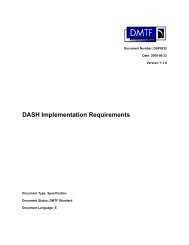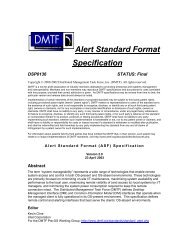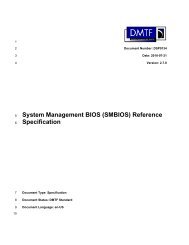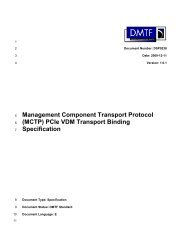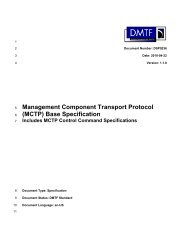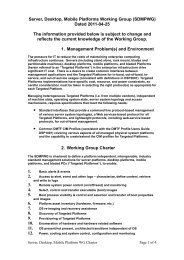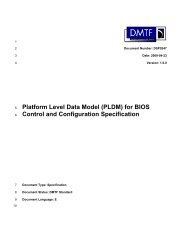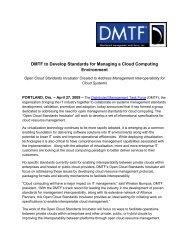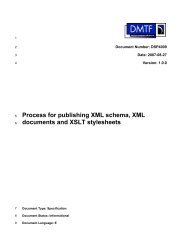Server Management Command Line Protocol Specification - DMTF
Server Management Command Line Protocol Specification - DMTF
Server Management Command Line Protocol Specification - DMTF
Create successful ePaper yourself
Turn your PDF publications into a flip-book with our unique Google optimized e-Paper software.
<strong>Server</strong> <strong>Management</strong> <strong>Command</strong> <strong>Line</strong> <strong>Protocol</strong> (SM CLP) <strong>Specification</strong><br />
574<br />
575<br />
576<br />
577<br />
578<br />
579<br />
580<br />
581<br />
582<br />
583<br />
584<br />
585<br />
586<br />
587<br />
588<br />
589<br />
590<br />
591<br />
592<br />
593<br />
594<br />
595<br />
596<br />
597<br />
598<br />
599<br />
600<br />
601<br />
602<br />
603<br />
604<br />
605<br />
606<br />
607<br />
608<br />
609<br />
610<br />
611<br />
612<br />
5 <strong>Server</strong> <strong>Management</strong> <strong>Command</strong> <strong>Line</strong> <strong>Protocol</strong> (SM CLP)<br />
<strong>Specification</strong><br />
The following clauses detail the requirements for the SM CLP.<br />
5.1 Semantics<br />
The <strong>Command</strong> <strong>Line</strong> <strong>Protocol</strong> (CLP) defines the form and content of messages transmitted from and<br />
responses received by a Client within the context of a text-based session between that Client and the<br />
CLP Service for a Manageability Access Point (MAP).<br />
The CLP consists of a set of command verbs that manipulate command targets representing Managed<br />
Elements (ME) that are within the scope of access by a MAP.<br />
Each CLP interaction consists of a <strong>Command</strong> <strong>Line</strong> transmitted to the CLP Service and a subsequent<br />
response transmitted back to the Client. Each command transmitted generates one and only one<br />
response data transmission to the Client.<br />
5.1.1 <strong>Command</strong> Verb<br />
A CLP command verb retrieves information about a target or initiates a state change of the target. A CLP<br />
interaction shall consist of one and only one command verb.<br />
5.1.2 <strong>Command</strong> Options<br />
CLP command options control the behavior of the command verb. All CLP option names are standard<br />
across the CLP command verb set. Implementations of the CLP shall not redefine the usage of a CLP<br />
option name across different CLP command verbs.<br />
5.1.3 <strong>Command</strong> Target<br />
This clause details requirements related to the usage and interpretation of a command target.<br />
5.1.3.1 General<br />
The command target identifies the specific Managed Element or Association that is to be affected by the<br />
command verb. All CLP commands have a command target, whether explicitly or implicitly identified. An<br />
explicitly identified target is a target address path that is included in the <strong>Command</strong> <strong>Line</strong> entered. An<br />
implicitly identified target is a target that is not identified in the <strong>Command</strong> <strong>Line</strong> entered but either is<br />
dictated by the command verb itself or is referenced from the session environment variable "Current<br />
Default Target". Implementations shall interpret command verbs submitted to the CLP only for the<br />
Resultant Target. The CLP also defines Reserved Targets. Reserved Targets are strings whose<br />
interpretation is defined by this specification. Reserved Targets can be used to construct the command<br />
target term. Implementations shall not define Reserved Targets beyond the ones defined in this<br />
specification. Implementations shall interpret Reserved Targets in accordance with the meaning assigned<br />
to them by this specification.<br />
This version of the SM CLP <strong>Specification</strong> supports the <strong>Server</strong> <strong>Management</strong> Managed Element (SM ME)<br />
Addressing <strong>Specification</strong> v1.0 (128H5HDSP0215).<br />
5.1.3.2 Current Default Target<br />
A Current Default Target address shall always be in effect during a CLP session. This target is used by<br />
the <strong>Command</strong> Processor to determine the Resultant Target for the command according to the rules of<br />
target address precedence defined in 129H5.1.3.3.<br />
18 Version 1.0.2



